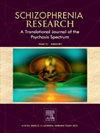Increased excitation enhances the sound-induced flash illusion by impairing multisensory causal inference in the schizophrenia spectrum
IF 3.5
2区 医学
Q1 PSYCHIATRY
引用次数: 0
Abstract
The spectrum of schizophrenia is characterised by an altered sense of self with known impairments in tactile sensitivity, proprioception, body-self boundaries, and self-recognition. These are thought to be produced by failures in multisensory integration mechanisms, commonly observed as enlarged temporal binding windows during audiovisual illusion tasks. To our knowledge, there is an absence of computational explanations for multisensory integration deficits in patients with schizophrenia and individuals with high schizotypy, particularly at the neurobiological level. We implemented a multisensory causal inference network to reproduce the responses of individuals who scored low in schizotypy in a simulated double flash illusion task. Next, we explored the effects of recurrent excitation, cross-modal and feedback weights, and synaptic density on the visual illusory responses of the network. Using quantitative fitting to empirical data, we found that an increase in the weights of the recurrent excitatory connectivity in the network enlarges the temporal binding window and increases the overall proneness to experience the illusion, matching the responses of individuals scoring high in schizotypy. Moreover, we found that an increase in excitation increases the probability of inferring a common cause from the stimuli. We propose an E/I imbalance account of reduced temporal discrimination in the SCZ spectrum and discuss possible links with Bayesian theories of schizophrenia. We highlight the importance of adopting a multisensory causal inference perspective to address body-related symptomatology of schizophrenia.

在精神分裂症谱系中,增加的兴奋通过损害多感官因果推理来增强声音诱导的闪光错觉
精神分裂症谱系的特点是自我意识改变,在触觉敏感性、本体感觉、身体-自我边界和自我识别方面存在已知障碍。这些被认为是由多感觉整合机制的失败产生的,通常在视听错觉任务期间观察到时间绑定窗口的扩大。据我们所知,对于精神分裂症患者和高度分裂型个体的多感觉统合缺陷,特别是在神经生物学水平上,缺乏计算解释。我们实施了一个多感官因果推理网络,以重现在模拟双闪幻觉任务中得分较低的分裂型个体的反应。接下来,我们探讨了循环激励、交叉模态和反馈权重以及突触密度对网络视觉错觉反应的影响。通过对经验数据的定量拟合,我们发现网络中反复兴奋性连接权重的增加扩大了时间绑定窗口,并增加了体验幻觉的总体倾向,这与分裂型中得分较高的个体的反应相匹配。此外,我们发现,刺激的增加增加了从刺激推断共同原因的可能性。我们提出了一种E/I失衡解释SCZ谱中时间歧视减少的原因,并讨论了与精神分裂症贝叶斯理论的可能联系。我们强调采用多感官因果推理的观点来解决精神分裂症的身体相关症状的重要性。
本文章由计算机程序翻译,如有差异,请以英文原文为准。
求助全文
约1分钟内获得全文
求助全文
来源期刊

Schizophrenia Research
医学-精神病学
CiteScore
7.50
自引率
8.90%
发文量
429
审稿时长
10.2 weeks
期刊介绍:
As official journal of the Schizophrenia International Research Society (SIRS) Schizophrenia Research is THE journal of choice for international researchers and clinicians to share their work with the global schizophrenia research community. More than 6000 institutes have online or print (or both) access to this journal - the largest specialist journal in the field, with the largest readership!
Schizophrenia Research''s time to first decision is as fast as 6 weeks and its publishing speed is as fast as 4 weeks until online publication (corrected proof/Article in Press) after acceptance and 14 weeks from acceptance until publication in a printed issue.
The journal publishes novel papers that really contribute to understanding the biology and treatment of schizophrenic disorders; Schizophrenia Research brings together biological, clinical and psychological research in order to stimulate the synthesis of findings from all disciplines involved in improving patient outcomes in schizophrenia.
 求助内容:
求助内容: 应助结果提醒方式:
应助结果提醒方式:


